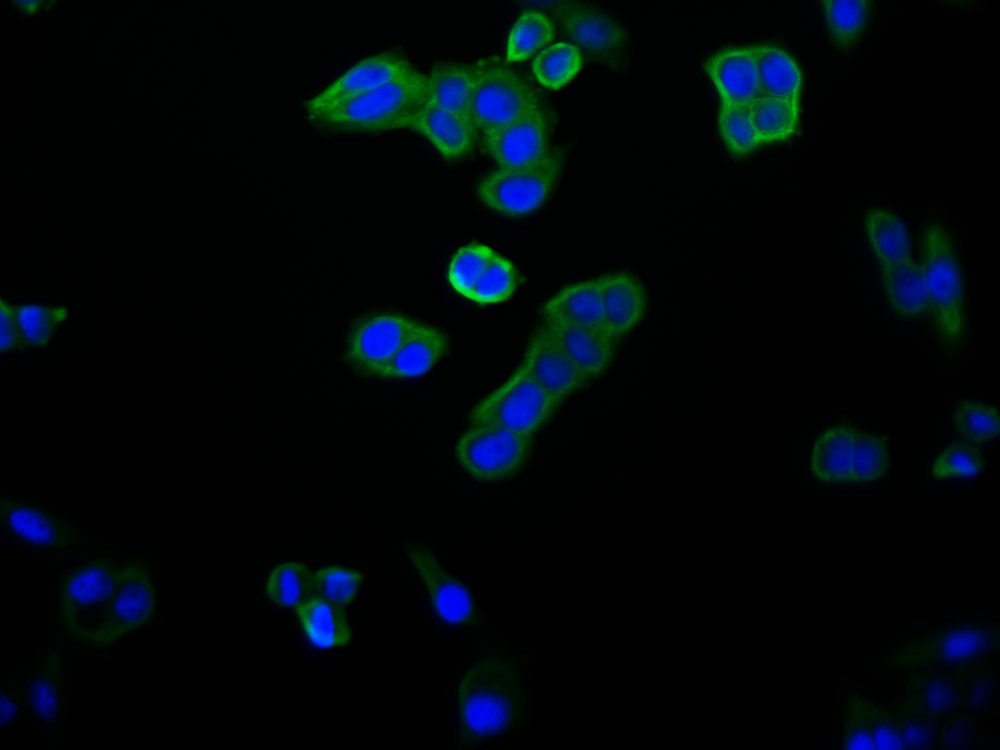PPARA Antibody
-
中文名稱:PPARA兔多克隆抗體
-
貨號:CSB-PA112569
-
規(guī)格:¥1100
-
圖片:
-
其他:
產(chǎn)品詳情
-
Uniprot No.:
-
基因名:
-
別名:hPPAR antibody; MGC2237 antibody; MGC2452 antibody; NR1C1 antibody; Nuclear receptor subfamily 1 group C member 1 antibody; OTTHUMP00000197740 antibody; OTTHUMP00000197741 antibody; Peroxisome proliferative activated receptor alpha antibody; Peroxisome proliferator activated receptor alpha antibody; Peroxisome proliferator-activated receptor alpha antibody; PPAR antibody; PPAR-alpha antibody; ppara antibody; PPARA_HUMAN antibody; PPARalpha antibody
-
宿主:Rabbit
-
反應(yīng)種屬:Human,Mouse,Rat
-
免疫原:Synthetic peptide of Human PPARA
-
免疫原種屬:Homo sapiens (Human)
-
標(biāo)記方式:Non-conjugated
-
抗體亞型:IgG
-
純化方式:Antigen affinity purification
-
濃度:It differs from different batches. Please contact us to confirm it.
-
保存緩沖液:-20°C, pH7.4 PBS, 0.05% NaN3, 40% Glycerol
-
產(chǎn)品提供形式:Liquid
-
應(yīng)用范圍:ELISA,WB
-
推薦稀釋比:
Application Recommended Dilution ELISA 1:1000-1:5000 WB 1:200-1:1000 -
Protocols:
-
儲(chǔ)存條件:Upon receipt, store at -20°C or -80°C. Avoid repeated freeze.
-
貨期:Basically, we can dispatch the products out in 1-3 working days after receiving your orders. Delivery time maybe differs from different purchasing way or location, please kindly consult your local distributors for specific delivery time.
相關(guān)產(chǎn)品
靶點(diǎn)詳情
-
功能:Ligand-activated transcription factor. Key regulator of lipid metabolism. Activated by the endogenous ligand 1-palmitoyl-2-oleoyl-sn-glycerol-3-phosphocholine (16:0/18:1-GPC). Activated by oleylethanolamide, a naturally occurring lipid that regulates satiety. Receptor for peroxisome proliferators such as hypolipidemic drugs and fatty acids. Regulates the peroxisomal beta-oxidation pathway of fatty acids. Functions as transcription activator for the ACOX1 and P450 genes. Transactivation activity requires heterodimerization with RXRA and is antagonized by NR2C2. May be required for the propagation of clock information to metabolic pathways regulated by PER2.
-
基因功能參考文獻(xiàn):
- Ubiquitination modification through the coordinated action of PAQR3 with HUWE1 plays a crucial role in regulating the activity of hepatic PPARalpha in response to starvation. PMID: 29331071
- Circulated eosinophilic expression of PPARalpha protein is reduced in metabolic syndrome. PMID: 29699951
- TNFalpha differently regulated the levels of PPARalpha, LXRalpha, and LXRbeta binding to the apoA-I gene promoter in THP-1 cells. Obtained results suggest a novel tissue-specific mechanism of the TNFalpha-mediated regulation of apoA-I gene in monocytes and macrophages and show that endogenous ApoA-I might be positively regulated in macrophage during inflammation. PMID: 29442267
- MAR1 ameliorates LPS-induced atherosclerotic reactions via PPARalpha-mediated suppression of inflammation and ER stress. PMID: 29971543
- Data suggest that, in hepatocytes, MIRN34A plays roles in regulation of mitochondrial remodeling and lipid metabolism including development/prevention of non-alcoholic fatty liver disease; MIRN34A appears to act via AMPK/PPARalpha signal transduction. (MIRN34A = microRNA 34a; AMPK = AMP-activated protein kinase; PPARalpha = peroxisome proliferator activated receptor alpha) PMID: 29197627
- miR-214 overexpression inhibits glioma cell growth in vitro and in vivo by inducing cell cycle arrest in G0/G1. Collectively, these data uncover a novel role for a PPARalpha-miR-214-E2F2 pathway in controlling glioma cell proliferation. PMID: 29862267
- Improvements in metabolic and neurodegenerative diseases are often attributed to anti-inflammatory effects of PPAR activation. (Review) PMID: 29799467
- circRNA_0046366, which demonstrated expression loss in HepG2-based hepatocellular steatosis, exerts antagonistic effect on miR-34a activity. miR-34a inactivation abrogates its inhibitory role against PPARalpha. PMID: 29391755
- We first reported that the FOMX1 pathway is the most upregulated and the PPARalpha pathway is the most downregulated pathway in Triple Negative Breast Cancers (TNBCs). These two pathways could be simultaneously targeted in further studies. Also the pathway classifier we performed in this study provided insight into the TNBC heterogeneity. PMID: 29301506
- Polymorphism of PPARA is associated with late onset of type 2 diabetes mellitus. PMID: 28292576
- results demonstrated that OEA exerts anti-inflammatory effects by enhancing PPARalpha signaling, inhibiting the TLR4-mediated NF-kappaB signaling pathway, and interfering with the ERK1/2-dependent signaling cascade (TLR4/ERK1/2/AP-1/STAT3), which suggests that OEA may be a therapeutic agent for inflammatory diseases. PMID: 27721381
- data suggested that miR-19a negatively controlled the autophagy of hepatocytes attenuated in D-GalN/LPS-stimulated hepatocytes via regulating NBR2 and AMPK/PPARalpha signaling. PMID: 28586153
- The minor allele of rs1800206 and rs1805192 from PPAR A and PPAR G and its interaction were associated with increased Breast Cancer risk. PMID: 28669518
- High concentrations of DINCH urinary metabolites activate human PPAR-alpha. PMID: 29421333
- PPARalpha is overexpressed in primary glioblastoma PMID: 27926792
- these results suggest that the E2F1/miR19a/PPARalpha feedback loop is critical for glioma progression PMID: 27835866
- Data conclude that the ER-stress mediated reduction in apoA-I transcription could be partly mediated via the inhibition of PPARalpha mRNA expression and activity. In addition, BET inhibition increased apoA-I transcription, even if PPARalpha production and activity were decreased. Both BET inhibition and PPARalpha activation ameliorate the apoA-I lowering effect of ER-stress and are therefore interesting targets to elev... PMID: 28012209
- Results demonstrated that PPARa directly inhibited Glut1 mRNA expression resulting in influx of glucose in cancer cells. PMID: 27918085
- PPARalpha and LXRalpha may be mediators by which omega3PUFA attenuate bile acid-induced hepatocellular injury PMID: 26756785
- Our results support an important association between rs1800206 minor allele of PPAR alpha and diabetic retinopathy, and the interaction analysis also shown a combined effect of Leu162 allele-abdominal obesity interaction on diabetic retinopathy. PMID: 26671228
- Taken together, our data suggest that eupatilin inhibits TNFalpha-induced MMP-2/-9 expression by suppressing NF-kappaB and MAPKAP-1 pathways via PPARalpha. Our findings suggest the usefulness of eupatilin for preventing skin aging. PMID: 28899779
- Hepatic PARP1 activation inhibits FAO pathway upregulation through poly(ADP-ribosyl)ation of PPARalpha, worsening hepatic steatosis and inflammatory responses associated with overnutrition. PMID: 27979751
- Aleglitazar protects cardiomyocytes against hyperglycaemia-induced apoptosis by combined activation of both peroxisome proliferator-activated receptor-alpha and peroxisome proliferator-activated receptor-gamma. PMID: 28111985
- Study reports a molecular mechanism by which glucocorticoid-induced PPARalpha expression negatively affects the activity of PPARgamma and downregulates BCO1 gene expression. Results explicate novel aspects of local glucocorticoid:retinoid interactions that may contribute to alveolar tissue remodeling in chronic lung diseases that affect children and, possibly, adults. PMID: 28732066
- Interference with PLIN2 and PPARalpha resulted in major alterations in gene expression, especially affecting lipid, glucose, and purine metabolism. PMID: 27308945
- PPARalpha and FXR function coordinately to integrate liver energy balance. PMID: 28287408
- This study showed that oleoylethanolamine and palmitoylethanolamine have endogenous roles and potential therapeutic applications in conditions of intestinal hyperpermeability and inflammation. PMID: 27623929
- An association was found with PPARalpha polymorphism and patients with nicotine dependency and schizophrenia. PMID: 27624431
- PPAR agonists have shown to have anti proliferative effect in squamous cell carcinoma of the head and neck. PMID: 27896820
- Results show that PPARalpha is downregulated and SREBP-1c is upregulated in steatosis L-02 cells. These changes increase lipid synthesis and reduce lipid disposal, which ultimately lead to hepatic steatosis. PMID: 27270405
- Perfluoroalkyl acids addition to activating PPARalpha as a primary target, also have the potential to activate CAR, PPARgamma, and ERalpha as well as suppress STAT5B. PMID: 28558994
- the metabolic events, controlled by PPARs, occurring during neuronal precursor differentiation, the glucose and lipid metabolism was investigated. PMID: 27860527
- The CYP2E1-PPARalpha axis may play a role in ethanol-induced neurotoxicity via the alteration of the genes related with synaptic function PMID: 28385499
- Studies indicate that natural dietary compounds, including nutrients and phytochemicals, are Peroxisome proliferator-activated receptor alpha (PPARalpha) ligands or modulators. PMID: 27863018
- Genome-wide comparison of the inducible transcriptomes of nuclear receptors CAR, PXR and PPARalpha in primary human hepatocytes has been presented. PMID: 26994748
- Hepatitis B virus increases the expression of alpha-mannosidases both in vitro and in vivo via activation of the PPARalpha pathway by its envelope protein. PMID: 27920474
- These observations candidate PPARs as new biomarkers of follicle competence opening new hypotheses on controlled ovarian stimulation effects on ovarian physiology. PMID: 26332656
- PPARalpha activation plays defensive and compensative roles by reducing cellular toxicity associated with fatty acids and sulfuric acid. PMID: 27644403
- PPARalpha/gamma agonist, elafibranor resolves nonalcoholic steatohepatitis without worsening fibrosis. PMID: 26874076
- The effects of fenofibrate on nonalcoholic fatty liver disease in the context of PPAR-alpha activation was studied. PMID: 27930988
- PPARA polymorphism is associated with the risk of coronary heart disease. PMID: 27512842
- Telmisartan improved the hyperglycemia-induced cardiac fibrosis through the PPARdelta/STAT3 pathway. PMID: 27519769
- A modest relationship was found between PPARalpha and AIP expression, both being significantly higher in the presence of pre-operative somatostatin analogues in somatotropinoma patients. PMID: 26872613
- Fenofibrate inhibited atrial metabolic remodeling in atrial fibrillation (AF) by regulating the PPAR-alpha/sirtuin 1/PGC-1alpha pathway indicating a novel therapeutic strategy for AF PMID: 26787506
- PPAR delta + 294TT genotype frequency in the Chinese Han population was higher than in the Chinese Uyghur population and may affect the risk of ischemic stroke. PMID: 26814631
- PPARalpha functions as an E3 ubiquitin ligase to induce Bcl2 ubiquitination and degradation, leading to increased cancer cell sensitivity in response to chemotherapy drugs. PMID: 26556865
- There was no statistically significant difference in the distribution of PPARalpha Leu162Val polymorphism between the ischemic stroke patients and controls in the Han ethnic group. PMID: 26671025
- results support an important association between rs1800206 minor allele (V) of PPAR alpha and lower CRP level; the interaction analysis showed a combined effect between rs1800206 and rs135539 on the lower CRP level PMID: 26497374
- PPAR-gamma and PTEN expressions are related to the clinical parameters and prognosis of renal cell carcinoma PMID: 26722456
- Describe a renoprotective role of fenofibrate in albumin bound fatty acid associated tubular toxicity, involving the transcriptional activation of PPARalpha and suppression of NF-kB. PMID: 26617775
顯示更多
收起更多
-
亞細(xì)胞定位:Nucleus.
-
蛋白家族:Nuclear hormone receptor family, NR1 subfamily
-
組織特異性:Skeletal muscle, liver, heart and kidney. Expressed in monocytes.
-
數(shù)據(jù)庫鏈接:
Most popular with customers
-
-
YWHAB Recombinant Monoclonal Antibody
Applications: ELISA, WB, IF, FC
Species Reactivity: Human, Mouse, Rat
-
Phospho-YAP1 (S127) Recombinant Monoclonal Antibody
Applications: ELISA, WB, IHC
Species Reactivity: Human
-
-
-
-
-





















